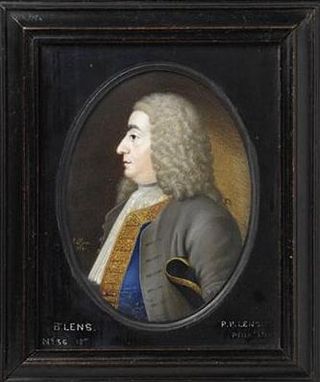Related Research Articles

Sir Godfrey Kneller, 1st Baronet was a German-British painter. The leading portraitist in England during the late Stuart and early Georgian eras, he served as court painter to successive English and British monarchs, including Charles II of England and George I of Great Britain. Kneller also painted scientists such as Isaac Newton, foreign monarchs such as Louis XIV of France and visitors to England such as Michael Shen Fu-Tsung. A pioneer of the kit-cat portrait, he was also commissioned by William III of England to paint eight "Hampton Court Beauties" to match a similar series of paintings of Charles II's "Windsor Beauties" that had been painted by Kneller's predecessor as court painter, Peter Lely.

Joan Beaufort was Queen of Scotland from 1424 to 1437 as the spouse of King James I of Scotland. During part of the minority of her son James II, she served as the regent of Scotland.

Rowland Lockey was an English painter and goldsmith, and was the son of Leonard Lockey, a crossbow maker of the parish of St Bride's, Fleet Street, London. Lockey was apprenticed to Queen Elizabeth's miniaturist and goldsmith Nicholas Hilliard for eight years beginning Michaelmas 1581 and was made a freeman or master of the Worshipful Company of Goldsmiths by 1600.

Henry Singleton was an English painter and miniaturist.

Catherine Howard was Queen of England from 1540 until 1541 as the fifth wife of King Henry VIII. She was the daughter of Lord Edmund Howard and Joyce Culpeper, a cousin to Anne Boleyn, and the niece of Thomas Howard, 3rd Duke of Norfolk. Thomas Howard was a prominent politician at Henry's court, and he secured her a place in the household of Henry's fourth wife, Anne of Cleves, where she caught the King's interest. She married him on 28 July 1540 at Oatlands Palace in Surrey, just 19 days after the annulment of his marriage to Anne. He was 49, and she was between 15 and 21 years old, though it is widely accepted that she was 17 at the time of her marriage to Henry VIII.

Bernard Lens III was an English artist known primarily for his portrait miniatures. Lens was the miniature painter at the courts of kings George I and George II, instructor in miniature painting to prince William and princesses Mary and Louise and consultant in fine arts to upper-class families.

Art in early modern Scotland includes all forms of artistic production within the modern borders of Scotland, between the adoption of the Renaissance in the early sixteenth century to the beginnings of the Enlightenment in the mid-eighteenth century.

Portrait painting in Scotland includes all forms of painted portraiture in Scotland, from its beginnings in the early sixteenth century until the present day. The origins of the tradition of portrait painting in Scotland are in the Renaissance, particularly through contacts with the Netherlands. The first portrait of a named person that survives is that of Archbishop William Elphinstone, probably painted by a Scottish artist using Flemish techniques around 1505. Around the same period Scottish monarchs turned to the recording of royal likenesses in panel portraits, painted in oils on wood. The tradition of royal portrait painting in Scotland was probably disrupted by the minorities and regencies it underwent for much of the sixteenth century. It began to flourish after the Reformation, with paintings of royal figures and nobles by Netherlands artists Hans Eworth, Arnold Bronckorst and Adrian Vanson. A specific type of Scottish picture from this era was the "vendetta portrait", designed to keep alive the memory of an atrocity. The Union of Crowns in 1603 removed a major source of artistic patronage in Scotland as James VI and his court moved to London. The result has been seen as a shift "from crown to castle", as the nobility and local lairds became the major sources of patronage.

Elizabeth Walker (1800–1876) was a British engraver and portrait-painter.

Susan Penelope Rosse (1652–1700) was an English painter. She painted portrait miniatures. She was the daughter of Richard Gibson. Her most notable artwork is a portrait of Gilbert Burnet.
Mary Anne Knight was an English miniature-painter, specialising in miniatures of children and babies. She was closely associated with Andrew Plimer, who married her sister.
Jessica Landseer (1810–1880) was an English landscape and miniature painter. She exhibited from 1816 to around 1838; then stopped while she kept house for her brother, Edwin Landseer. She continued to paint, however, and resumed exhibiting in 1863, while still caring for Edwin, who was in bad health in the last years of his life.
Miss Archibald Ramsay Douglas was a Scottish miniature painter. She was the daughter of William Douglas.
Rosalie Emslie was a British artist known for her landscape and portrait paintings.
Gladys Kathleen Madge Bell née Farrar (1882–1965) was a British artist and miniature painter.
May Bridges Lee (1884-1977), later Lady Stott, was an English portrait painter.
Edith Carr was a British artist, notable as a portrait and miniature painter.
Emily Grace Creswell was a British artist, known for painting portraits and miniatures.
Margaret Seguier was a British miniature painter.
Eliza Mary Burgess was a British artist, known as a painter and designer.
References
- 1 2 3 HCG Matthew & Brian Harrison, ed. (2004). Oxford Dictionary of National Biography Vol 52 (Spruce-Strakosch). Oxford University Press. ISBN 0-19-861402-0.
- 1 2 3 Peter J.M. McEwan (1994). The Dictionary of Scottish Art and Architecture. Antique Collectors' Club. ISBN 1-85149-134-1.
- ↑ Benezit Dictionary of Artists Volume 13 Sommer-Valverane. Editions Grund, Paris. 2006. ISBN 2-7000-3083-4.